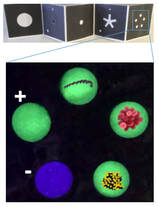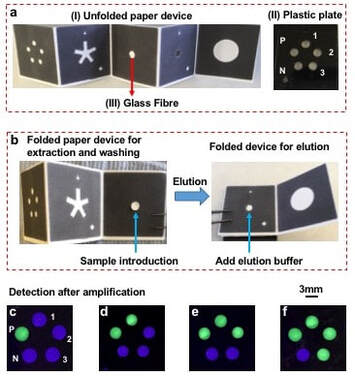Low-cost Paper-Origami Device for Point-of-Use Test
Lab-on-a-paper for microbial source tracking and wastewater-based epidemiology
The detection of microbial contamination together with its tracing and tracking in the environment is currently performed mainly by isolating, culturing and identifying the pathogens against known contaminants, through a long process that can take many days and extensive technical expertise. New procedures have been improved to enable faster testing via the molecular detection of specific genetic markers or the pathogens (< 1 hour), but these currently require centralised facilities and skilled personnel, preventing their use in the field. Our paper-origami device will allow the detection of multiple genetic markers rapidly, in the field. These highly multiplexed assays will provide the capability for industry to provide a rapid and dynamic response to a contamination, and to identify and track its source.
Most recently, we aim to use technology to trace the COVID-19 carrier with wastewater-based epidemiology for early warning pandemic and this work has been widely featured including Science and public media such as BBC, Daily Mail, Newsweek, Science Daily etc.
The detection of microbial contamination together with its tracing and tracking in the environment is currently performed mainly by isolating, culturing and identifying the pathogens against known contaminants, through a long process that can take many days and extensive technical expertise. New procedures have been improved to enable faster testing via the molecular detection of specific genetic markers or the pathogens (< 1 hour), but these currently require centralised facilities and skilled personnel, preventing their use in the field. Our paper-origami device will allow the detection of multiple genetic markers rapidly, in the field. These highly multiplexed assays will provide the capability for industry to provide a rapid and dynamic response to a contamination, and to identify and track its source.
Most recently, we aim to use technology to trace the COVID-19 carrier with wastewater-based epidemiology for early warning pandemic and this work has been widely featured including Science and public media such as BBC, Daily Mail, Newsweek, Science Daily etc.
2. Point-of-Care Diagnosis of Infectious disease in India and Malaria in Africa
The health and well-being of cattle is a significant concern for global agricultural output. In dairy production within low and middle income countries (LMICs), there is a significant biosensing challenge in detecting sexually transmitted infection (STI) pathogens during animal husbandry, due in part to difficulties associated with the limited infrastructure for veterinary medicine.
The health and well-being of cattle is a significant concern for global agricultural output. In dairy production within low and middle income countries (LMICs), there is a significant biosensing challenge in detecting sexually transmitted infection (STI) pathogens during animal husbandry, due in part to difficulties associated with the limited infrastructure for veterinary medicine.
We developed a low-cost, multiplexed and sample-to-answer paper-origami tests for the detection of three bovine infectious reproductive diseases in semen samples, collected at a test site in rural India. Pathogen DNA from one viral pathogen, Bovine Herpes virus-1 (BoHV-1) and two bacteria (Brucella and Leptospira) was extracted, amplified (using loop-mediated isothermal amplification, LAMP) and detected fluorescently, enabling <1 pg (~ from 115 to 274 copies per reaction) of target genomic DNA to be measured. Limits of detection and sensitivities of the paper-origami device for the three pathogens were also evaluated, i.g. 50 Leptospira organisms, 50 CFU Brucella and 1 TCID50. BoHV-1. Semen samples from elite bulls at a germplasm centre were also tested in double-blind tests, as a demonstrator for a low cost, user-friendly point-of-care sensing platform, for in-the-field resource-limited regions.
This low cost and easy-to-use platform enable a generic DNA detection platform for various samples, such as blood, urine, and water samples. We then further test it in Uganda for rapid diagnosis of malaria in Uganda in Africa, which was also validated with a polymerise chain reaction (PCR).
This low cost and easy-to-use platform enable a generic DNA detection platform for various samples, such as blood, urine, and water samples. We then further test it in Uganda for rapid diagnosis of malaria in Uganda in Africa, which was also validated with a polymerise chain reaction (PCR).
Featured References
6. Can a paper-based device trace COVID-19 sources with wastewater-based epidemiology?
Mao K, Zhang H, Yang Z*.
Environ Sci Technol, 2020 54 (7), 3733-3735.
5. Paper-based microfluidics for rapid diagnostics and drug delivery.
Mao K, Min X, Zhang H, Zhang K, Cao H, Guo Y, Yang Z*.
J Control Release, 2020, 322, 187-199. (IF 7.9)
4. Paper-based microfluidics for DNA diagnostics of malaria in low resource underserved rural communities
Reboud, J. , Xu, G., Garrett, A. , Adriko, M., Yang, Z. , Tukahebwa, E., Rowel, C. and Cooper, J. M.
PNAS 2019, 116 (11) 4834- 4842
3. Rapid veterinary diagnosis of bovine reproductive infectious diseases from semen using paper-origami DNA microfluidics.
Yang Z, Xu G, Reboud J, Ali SA, Kaur G, McGiven J, Nongthombam B, Gupta PK, Chaudhuri P, Cooper JM.
ACS Sens, 2018, 3(2), 403-409.
2. Graphene nanocomposites modified electrochemical aptamer sensor for rapid and highly sensitive detection of prostate specific antigen
Wei B, Mao K, Liu N, Zhang M*, Yang Z*.
Biosens Bioelectron 2018, 121, 41-46. PDF (IF 9.5)
1. Monitoring Genetic Population Biomarkers for wastewater-based epidemiology.
Yang Z#, Xu G#, Reboud J, Kasprzyk-Horden B, Cooper JM.
Anal Chem 2017, 89 (18), 9941–9945 (IF 6.320). PDF
Mao K, Zhang H, Yang Z*.
Environ Sci Technol, 2020 54 (7), 3733-3735.
5. Paper-based microfluidics for rapid diagnostics and drug delivery.
Mao K, Min X, Zhang H, Zhang K, Cao H, Guo Y, Yang Z*.
J Control Release, 2020, 322, 187-199. (IF 7.9)
4. Paper-based microfluidics for DNA diagnostics of malaria in low resource underserved rural communities
Reboud, J. , Xu, G., Garrett, A. , Adriko, M., Yang, Z. , Tukahebwa, E., Rowel, C. and Cooper, J. M.
PNAS 2019, 116 (11) 4834- 4842
3. Rapid veterinary diagnosis of bovine reproductive infectious diseases from semen using paper-origami DNA microfluidics.
Yang Z, Xu G, Reboud J, Ali SA, Kaur G, McGiven J, Nongthombam B, Gupta PK, Chaudhuri P, Cooper JM.
ACS Sens, 2018, 3(2), 403-409.
2. Graphene nanocomposites modified electrochemical aptamer sensor for rapid and highly sensitive detection of prostate specific antigen
Wei B, Mao K, Liu N, Zhang M*, Yang Z*.
Biosens Bioelectron 2018, 121, 41-46. PDF (IF 9.5)
1. Monitoring Genetic Population Biomarkers for wastewater-based epidemiology.
Yang Z#, Xu G#, Reboud J, Kasprzyk-Horden B, Cooper JM.
Anal Chem 2017, 89 (18), 9941–9945 (IF 6.320). PDF


